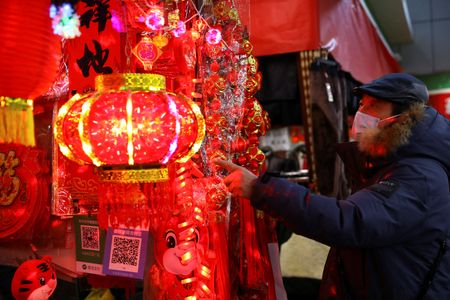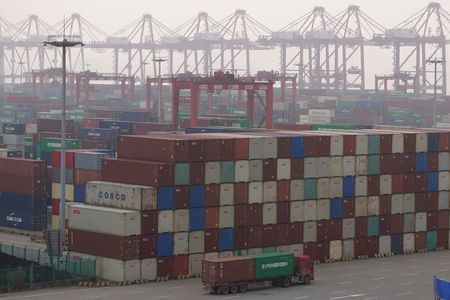

By Kevin Yao and Gabriel Crossley
BEIJING (Reuters) -China’s economy rebounded in 2021 from its pandemic-induced slump helped by robust exports but weak consumption at the year-end and a property slowdown point to cooling momentum and the need for more policy support.
The central bank on Monday cut loan rates to cushion the world’s second-largest economy as its confronts headwinds from a rapidly cooling property sector and sporadic COVID-19 outbreaks.
Several Chinese cities went on high COVID-19 alert ahead of the Lunar New Year holiday travel season, as the Omicron variant reached more areas including Beijing.
The economy grew 8.1% in 2021, faster than a forecast 8.0% and well above a government target of “above 6%” and 2020’s revised growth of 2.2%.
Gross domestic product (GDP) expanded 4.0% in the October-December period from a year earlier, according to National Bureau of Statistics data, faster than expected but still its weakest pace in one-and-half years. Growth was 4.9% in the third quarter.
On a quarter-on-quarter basis, GDP rose 1.6% in October-December, compared with expectations for a 1.1% rise and a revised 0.7% gain in the previous quarter.
China’s economy got off to a strong start in 2021 as activity rebounded but it has lost steam due to a property downturn, curbs on debt and strict anti-virus measures which have hit consumption.
China’s central bank unexpectedly cut the borrowing costs of its medium-term loans for the first time since April 2020, leading some analysts to expect more policy easing this year to guard against developers’ mounting risk of default.
The People’s Bank of China (PBOC) said it was lowering the interest rate on 700 billion yuan ($110.2 billion) worth of one-year medium-term lending facility (MLF) loans to some financial institutions by 10 basis points to 2.85% from 2.95% in previous operations.
“Economic momentum remains weak amid repeated virus outbreaks and a struggling property sector. As such, we anticipate another 20 bps of cuts to PBOC policy rates during the first half of this year,” said analysts at Capital Economics, in a note.
PROPERTY, RETAIL SALES SLOW
China’s property market has slowed since June as regulators stepped up their deleveraging campaign against the bloated sector, triggering defaults at some heavily indebted companies.
Property investment dropped 13.9% in December from a year earlier, falling at the fastest pace since early 2020, according to Reuters calculations based on official data. Investment grew 4.4% in 2021, the slowest since 2016.
Weak consumption data also clouded the outlook, with retail sales in December missing expectations with only a 1.7% increase from a year earlier, the slowest pace since August 2020. Analysts in the poll had expected them to grow 3.7% after rising 3.9% in November.
“The biggest challenge this year for policymakers is how to stabilise the economy at a 5-5.5% range against the backdrop of dynamic zero-COVID policy,” said Nie Wen, chief economist at Hwabao Trust in Shanghai.
A bright spot was industrial output, up an annual 4.3% in December, picking up from a 3.8% increase in November, and better than a 3.6% increase in a Reuters poll.
Fixed asset investment rose 4.9% in 2021, compared with the 4.8% increase tipped by analysts and 5.2% in the first 11 months of the year.
Booming shipments to coranavirus-hit economies overseas were a key boost to China’s growth last year, with net exports accounting for more than a quarter of GDP growth in Q4 and the country logging its biggest trade surplus in 2021 since records started in 1950.
The outsized role that net exports played in last year’s GDP growth also underscored the relative weakness in other drivers. By contrast, net exports were a drag on overall growth in 2018, when the economy relied more on consumption and investment.
However, the support from export growth may not last. It has been slowing as an overseas surge in demand for goods eases and high costs pressure exporters.
(Additional reporting by Stella Qiu and Liangping Gao; Editing by Jacqueline Wong)

